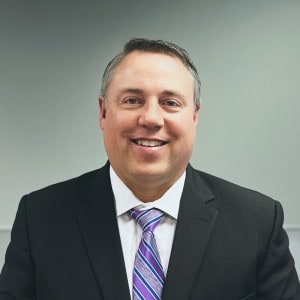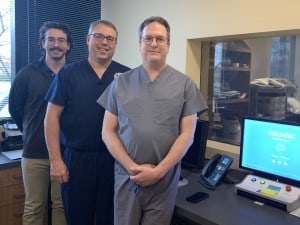Regional One Health is the first hospital in Tennessee to offer focused ultrasound, a non-surgical procedure that offers effective relief for hand tremors from Essential Tremor.
Recently, focused ultrasound program director Dr. Jason Gerrard used his experience and expertise to help prepare a fellow neurosurgeon to provide this state-of-the-art-procedure.
Dr. Gerrard said it’s rewarding to be able to not only help patients in the Mid-South, but to help expand the availability of focused ultrasound nationwide.
As the first hospital in Tennessee to offer focused ultrasound, Regional One Health has built a wealth of experience providing this cutting-edge procedure for patients who struggle with hand tremors due to Essential Tremor.
Neurosurgeon Jason Gerrard, MD, Ph.D., director of Regional One Health’s Focused Ultrasound program, is using that experience to help other providers learn about the procedure. Dr. Gerrard recently hosted fellow neurosurgeon William Anderson, MD, Ph.D., MA from prestigious Johns Hopkins Hospital to observe a pair of focused ultrasound treatments.
“This is a new technology,” Dr. Gerrard said. “It’s important to not only understand the science, but to also see cases, because that’s how you learn the art. Dr. Anderson is very familiar with the science, but to learn the art, you have to be present for a number of these cases.”
Dr. Anderson said observing focused ultrasound in action is an important step as he prepares to offer the procedure this fall. “I’m thankful I was able to come. Dr. Gerrard is a great physician, and he was very helpful,” he said. “With any new surgical procedure, there are idiosyncrasies that you can only pick up through being there and watching someone do cases.”
In the case of focused ultrasound, Dr. Anderson observed a well-coordinated process that helped two patients attain significant hand tremor relief over the course of just a few hours – all with no incision or hospital stay.
Focused ultrasound uses ultrasound energy guided by MR imaging to treat the precise spot in the brain that is responsible for tremor.
To start, the patient’s head is shaved and they are fitted with a special helmet that allows water to circulate around the skull. Both of these steps help the ultrasound waves pass through the skull.

Neurosurgeon Dr. Jason Gerrard is director of Regional One Health’s Focused Ultrasound program. He says the procedure is an excellent option for patients: “It gives people a safe, effective treatment option without surgery.”
After that, the patient lies on a treatment table that goes in and out of the MRI several times over the course of two to three hours. The patient is awake and alert throughout the procedure.
Dr. Gerrard first uses the MRI to identify the exact spot in the brain that is causing the tremor. Then, he guides ultrasound waves to create a small therapeutic ablation, or burn, to treat the spot.
During the procedure, the patient is asked to perform simple tasks, such as drawing a spiral or touching their finger to Dr. Gerrard’s. This helps Dr. Gerrard make sure the procedure is working and make any adjustments that are necessary.
After the procedure, the patient is taken to a recovery room and assessed by the medical team to be cleared to go home.
Dr. Anderson said it was impressive to see the results patients gain from the procedure, all with low risk and very few side effects.
“These tremors can be very disruptive to the patient and their ability to perform activities of daily living. They may be having trouble drinking from a glass; they can’t write checks,” he said. “The procedure has a very good success rate in terms of restoring function, and it helps with their social comfort as well. It allows them to go out and feel better about themselves.”
Dr. Anderson looks forward to offering focused ultrasound to his patients and said watching the process in person gave him an even better idea of what to expect.
“We learned about some of the things that can come up during a focused ultrasound,” he said. “For example, everyone’s skull has a different anatomy. That affects how the sound waves are transmitted to the treatment spot, so we learned how to handle variations in skull thickness. We learned how to keep the patient’s head still considering everyone’s head is a different size.”

Dr. Gerrard recently helped fellow neurosurgeon Dr. William Anderson, from Johns Hopkins Hospital, prepare to offer focused ultrasound procedures to his patients.
For Dr. Gerrard, being able to help other neurosurgeons prepare to provide focused ultrasound is rewarding, as he has seen firsthand how life-changing the procedure can be.
“Many of our patients are older, and it’s a great option for them. Sometimes these patients don’t have another treatment option due to comorbidities, or they simply don’t want to undergo brain surgery,” he said. “This gives people a safe, effective treatment option without surgery.”
He’s glad he can provide both training and treatment through Regional One Health.
“It’s very impressive to me that Regional One Health, as a public hospital system, was one of the first 30 to 40 places in the country to have this technology,” Dr. Gerrard said. “It’s an amazing asset for the Mid-South, and we’ve treated patients from all over the region.”
That should continue to grow in the future.
Dr. Gerrard said the medical community is studying how various types of focused ultrasound can be used for conditions ranging from Alzheimer’s disease to addiction to movement disorders.
“I expect this technology will be increasingly utilized in the future to treat many different disorders,” he said. “We can really help a lot of people.”